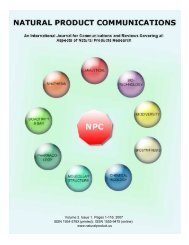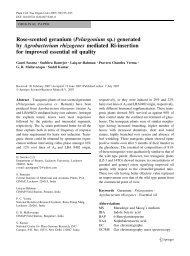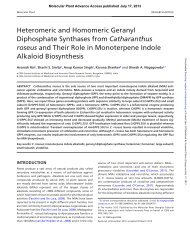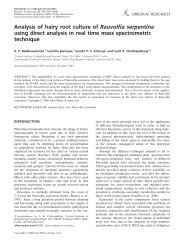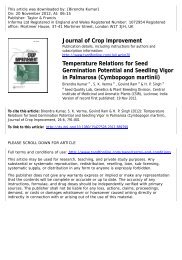Karuna Shanker, Madan M. Gupta, Santosh K ... - CIMAP Staff
Karuna Shanker, Madan M. Gupta, Santosh K ... - CIMAP Staff
Karuna Shanker, Madan M. Gupta, Santosh K ... - CIMAP Staff
You also want an ePaper? Increase the reach of your titles
YUMPU automatically turns print PDFs into web optimized ePapers that Google loves.
ARTICLE IN PRESSK. <strong>Shanker</strong> et al. / Food Chemistry xxx (2007) xxx–xxx 32.3. Equipment and chromatographic conditionsThe HPLC analysis have been carried out on Watersequipment: pump 600E; auto-injector-717plus; columnoven; detector-996 PDA. Data acquisition and computationwere carried out with Waters Melenium Ò software.Analyses were carried out on Merck Chromolith RP18ecolumn, 5 lm (100 4.6 mm i.d.). Typical chromatogramsare shown in Figs. 1 and 2.All of the standards and extracts were filtered through a0.45 lm syringe membrane filter (Type Millipore) and analyzedby HPLC. Analysis was carried out at 25 °C onaChromolith RP18e (Merck) column. Prior to use, solventswere filtered with 0.45 lm, 50 mm diameter membrane filter(Millipore) and sonicated for 15 min in a Micro clean109 bath (Oscar, India). Chromatography was carriedout using mobile phase of methanol–sodium dihydrogenphosphate–acetic acid buffer (0.1 M, pH 3.8) (20:80) (%v/v). The flow rate during the analysis was 0.7 ml/minand peaks were detected at 220 nm. Although detectionat 275 nm was more selective but detection at 220 nmwas more sensitive and did not pose a problem in termsof co-elution with impurities. Therefore, quantitation ofniaziridin and niazirin was performed at 220 nm peak areadata.2.4. Procedure2.4.1. Extraction of M. oleifera tissuesThe dried powdered leaves, pods and bark (2 g each) ofM. oleifera were extracted with 25 ml of various combinationsof ethanol–aqueous solution (0%, 20%, 40%, 60%,80%, 100%, v/v) by incubation at 30 °C for 24 h. Eachextract was filtered and solvent removed under vacuumat 40 °C. The residue was re-dissolved in 3 ml of HPLCgrade methanol. Niaziridin and niazirin in various extractswere analyzed by an analytical HPLC system. It wasobserved that the extractability of niaziridin was greatlyinfluenced by the ratio of extracting solvent mixtures i.e.ethanol–water. The most effective solvent for the maximumextraction of niaziridin and niazirin was 40% ethanol inwater for pods and 60% ethanol in water for leaves(Fig. 3). Both the markers were not extracted from barksample under experiment conditions studied. Thus weA. Pods (40% ethanol) Extract B. Leaves (60% ethanol) Extract C. Bark (20% ethanol) Extractat 220nm220nm220nm1.50AU 1.000.50Niaziridin (1)Niazirin (2)1.501.00AU0.50Niaziridin (1)Niazirin (2)0.800.60AU0.400.200.0010.00 20.00 30.00Minutes0.0010.00 20.00 30.00Minutes0.0010.00 20.00 30.00Minutes275nm275nm275nm2.00AU1.000.800.60AU0.400.20AU0.100.200.0010.00 20.00 30.00Minutes0.0010.00 20.00 30.00Minutes0.0010.00 20.00 30.00MinutesContour plot of A.Contour plot of B.Contour plot of C.350.00nm 300.00350.00nm300.00350.00nm300.00250.00250.00250.00200.005.00 30.00Minutes200.005.00 30.00Minutes200.005.00 30.00MinutesFig. 2. HPLC profile of: (A) pods, (B) leaves and (C) bark of M. oleifera analyzed by absorbence at 220 nm and 275 nm, contour plot of HPLC pattern of:(A) pods, (B) leaves and (C) bark of M. oleifera UV absorbance at 190–400 nm, respectively.Please cite this article in press as: <strong>Shanker</strong>, K. et al., Determination of bioactive nitrile glycoside(s) in drumstick ..., Food Chemistry(2007), doi:10.1016/j.foodchem.2006.12.034




